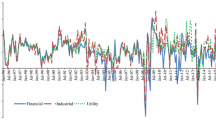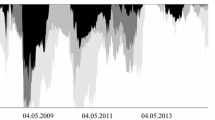Abstract
We examine the risk and return characteristics of fundamental weighting schemes for developed, emerging, and frontier government bond markets and compare these to market-capitalization-weighted indexes. We document positive excess returns for the investment grade sample only when currency risks are not hedged, suggesting that fundamentals might be more important for currency rather than bond returns. For emerging and frontier markets, we find positive excess returns for fundamental weighting schemes, although not always statistically significant. The excess returns from fundamental weighting schemes for government bonds can be explained by standard factors from equity, currency, or bond markets.
Similar content being viewed by others
References
Arnott, R. D, Hsu, J. C., Li, F. and Shepherd, S. S. (2010) Value-indifferent weighting for bonds. Journal of Portfolio Management 36(3): 117–130.
Arnott, R. D., Hsu, J. C. and Moore, P. (2005) Fundamental indexation. Financial Analysts Journal 61(2): 83–99.
Barroso, P. and Santa-Clara, P. (2015) Beyond the carry trade: Optimal currency portfolios. Journal of Financial and Quantitative Analysis 50(5): 1037–1056.
Blitz, D. and Swinkels, L. (2008) Fundamental indexation: An active value strategy in disguise. Journal of Asset Management 9(4): 264–269.
Bolla, L. (2017) Fundamental indexing in global bond markets: The risk exposure explains it all. Financial Analysts Journal 73(1): 101–120.
De Jong, M. and Wu, H. (2014) Fundamental indexation for bond markets. Journal of Risk Finance 15(3): 264–274.
Duyvesteyn, J. and Martens, M. (2014) Emerging government bond market timing. Journal of Fixed Income 23(3): 36–49.
Duyvesteyn, J., Martens, M. and Verwijmeren, P. (2016) Political risk and expected government bond returns. Journal of Empirical Finance 38(A): 498–512.
Eichengreen, B., Hausmann, R. and Panizza, U. (2005) The pain of original sin. In: B. Eichengreen and R. Hausmann (eds.) Other People’s Money: Debt Denomination and Financial Instability in Emerging-Market Economies. Chicago: University of Chicago Press, pp. 13–47.
Fama, E. and French, K. (1993) Common risk factors in the returns on stocks and bonds. Journal of Financial Economics 33(1): 3–56.
Ilmanen, A. (1995) Time-varying expected returns in international bond markets. Journal of Finance 50(2): 481–506.
Ilmanen, A. and Sayood, R. (2002) Quantitative forecasting models and active diversification for international bonds. Journal of Fixed Income 12(3): 40–51.
Kroencke, T., Schindler, F. and Schrimpf, A. (2014) International diversification benefits with foreign exchange investment styles. Review of Finance 18(5): 1847–1883.
Perold, A. (2007) Fundamentally flawed indexing. Financial Analysts Journal 63(6): 31–37.
Piljak, V. and Swinkels, L. (2015) Frontier and emerging government bond markets. Emerging Markets Review, online publication, http://dx.doi.org/10.1016/j.ememar.2015.10.002.
Shepherd, S. (2012) A fundamentally weighted broad-based fixed-income index. Journal of Indexes 15: 20–23.
Thomas, C. and Bennyhoff, D. (2012) A review of alternative approaches to fixed income indexing. Journal of Indexes 15: 10–19.
Acknowledgements
We would like to thank seminar participants of the University of Neuchatel for helpful comments. Swinkels is also affiliated with Robeco Institutional Asset Management. The views expressed in this paper do not necessarily represent the views of Robeco or any of its subsidiaries. Part of this paper was written when Swinkels was affiliated with Norges Bank Investment Management.
Author information
Authors and Affiliations
Corresponding author
APPENDIX
APPENDIX
Rights and permissions
About this article
Cite this article
Piljak, V., Swinkels, L. Fundamental indexation for developed, emerging, and frontier government bond markets. J Asset Manag 18, 405–420 (2017). https://doi.org/10.1057/s41260-017-0045-8
Revised:
Published:
Issue Date:
DOI: https://doi.org/10.1057/s41260-017-0045-8




